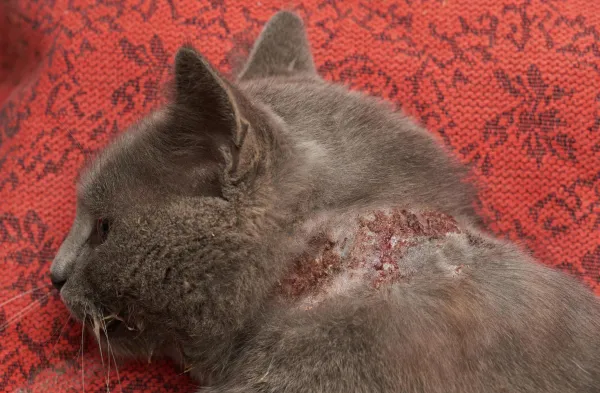How to Clean Cat Wounds with Salt Water

In this article, we will teach you some self-care methods on how to clean Cat wounds with salt water.
Cats by nature are very adventurous and energetic animals. It is quite common for them to get themselves injured in fights with other animals, or from other harmful objects in the environment. Not all of these injuries warrant a visit to the Vet however and can be treated using home recipes.
Table Of Contents
Benefits of Using Salt Water for Wounds
When it comes to wound care, the use of salt water, also known as saline solution, has gained popularity for its potential benefits. Salt water has been used for centuries as a natural remedy for various ailments, including wound healing.
Saltwater has also been scientifically proven (and tested) to improve the healing process for wounds in both animals and humans. It helps to clean and promote healing by a process called osmosis.
Let’s take a look at some of the advantages of using salt water for cat wound care and why it can be an effective addition to your first aid routine.
Cleansing Properties
Salt water acts as a natural antiseptic, effectively cleansing wounds by inhibiting the growth of bacteria and other microorganisms. The high salt concentration creates an inhospitable environment for these harmful pathogens, reducing the risk of infection. Additionally, salt water can help remove debris and foreign particles from the wound, promoting a clean and healthy healing process.
Gentle and Non-Irritating
Compared to some harsh antiseptic solutions, salt water is generally gentle and non-irritating to the skin. This makes it suitable for individuals with sensitive skin or those who may experience discomfort when using certain antiseptics. Salt water is less likely to cause stinging or burning sensations, making it a more comfortable option for wound care.
Maintains Moist Environment
Maintaining a moist wound environment is crucial for optimal healing. Salt water helps keep the wound hydrated, preventing it from drying out and forming scabs prematurely. This moist environment supports the growth of new tissue and encourages faster healing. Additionally, salt water can help minimize the formation of crusts, which can impede healing and increase the risk of scarring.
Reduces Swelling and Inflammation
Salt water has mild anti-inflammatory properties, which can help reduce swelling and inflammation around the wound. By alleviating these symptoms, salt water can provide relief and create a more conducive environment for the healing process. However, it’s important to note that if the wound shows signs of severe inflammation or if there are other underlying medical conditions, it is advisable to consult a healthcare professional for appropriate treatment.
Easy Preparation and Accessibility
One of the notable advantages of using salt water for wound care is its simplicity and accessibility. You can easily prepare a salt water solution at home by dissolving a teaspoon of salt in a cup of sterile or boiled water. Alternatively, ready-made saline solutions can be purchased at most pharmacies. The convenience and affordability of salt water make it a practical choice for everyday wound care.
While salt water can provide several benefits for wound care, it’s essential to remember that it may not be suitable for all types of wounds or individuals. Deep or severe wounds, wounds with excessive bleeding, or wounds requiring medical attention should be assessed and treated by a healthcare professional. It is always advisable to consult a healthcare provider for proper wound care guidance and to determine the most appropriate course of action.

Preparing the Wound
Before we actually begin treating the wound, there are a few things we need to do.
- First, make sure the wound has stopped bleeding. If not, use some clean dry cloth or gauze (the absorbent kind) and apply pressure on the wound until the bleeding stops.
- After this, remove any obstacles or obstructions from the wound (e.g loose fur, wood chips, or dirt). You can use distilled water to clean out the wound.
- Once the wound is clean and visible, you should easily be able to identify the severity of the wound. If the wound appears to be severe, or your cat is experiencing significant discomfort, your best option would be to go to the Vet.
How to Clean Cat Wounds with Salt Water (Steps)

We will now prepare a Saline solution using salt water to clean the wounds on the Cat.
- You need to first prepare about 1 quart or 1 liter of distilled water. If you do not have that, you can prepare sterile water by boiling tap water. Make sure to wait until it has cooled down before proceeding.
- Add 2 tablespoons of salt. Make sure to use the correct ratio of salt to water. For example, if you only use 1/2 liter of water, then use only 1 tablespoon of salt. In other words, for every liter of water, use 2 tablespoons of salt.
- Stir the water vigorously until all the salt has dissolved completely, ensuring no visible salt particles remain.
- There are two ways of applying the salt water solution to clean your cat’s wounds. The first method is to gently pour the prepared saline solution directly over the wound. Use a cup or a clean squeeze bottle to carefully and evenly apply the solution, ensuring it reaches all areas of the wound. The gentle flow of the saline solution helps remove debris, dirt, and bacteria.
The second method involves soaking a clean cloth or sterile gauze in the salt water solution. Gently wring out any excess liquid, ensuring the cloth or gauze is damp but not dripping. With gentle motions, use the damp cloth or gauze to clean the wound. Pat the wound lightly rather than rubbing, as excessive rubbing may cause irritation or discomfort to your cat. This method allows for more targeted and controlled cleaning. - Once it has been cleaned and flushed properly, wait until it becomes dry, and then bandage the open wound (if possible). You can use a “breathable” fabric such as gauze for the wound, as it allows air to pass through.
Observe your Cat
Remember to constantly monitor your Cat’s condition until the wound begins showing signs of recovery. If the wound worsens and appears to be showing signs of an infection, take it to the Vet immediately.
Common signs of infection are:
- Pus discharge from the wound
- Abscesses
- Fever or lethargy
- Noticeable pain or discomfort
- Sudden change in behavior
It is also vital to make sure your Cat does not try licking the wound too much or scratching itself, which could worsen the wound. You can consider buying an Elizabethan (cone) collar for your Cat to prevent this from happening. Other techniques include using “anti-licking” paste, or keeping your cat heavily distracted with toys and other forms of entertainment.
Conclusion and Additional Tips:
Using salt water for cleaning cat wounds can be an effective and accessible home remedy. It offers cleansing properties, is gentle on the skin, maintains a moist environment, reduces swelling and inflammation, and is easy to prepare. However, it’s important to remember that salt water may not be suitable for all wounds, and severe or deep wounds should be evaluated by a healthcare professional.
Here are a few additional tips to keep in mind when cleaning cat wounds with salt water:
- Stay calm and be gentle: Cats may become anxious or fearful when you try to clean their wounds. Approach the process calmly, speak softly to reassure them, and handle them with care to avoid causing additional stress or discomfort. If you appear to be in visible distress, this will likely cause distress to your cat too.
- Avoid using cotton swabs or harsh cleaning agents: Cotton swabs can leave behind fibers or break apart, which may further irritate the wound. Harsh cleaning agents, such as hydrogen peroxide or alcohol, can damage the healthy tissue and delay healing. Stick to the gentle salt water solution for cleaning.
- Ensure proper wound care after cleaning: Once the wound is clean and dry, you may need to apply an appropriate ointment or dressing as advised by your veterinarian. Follow their instructions carefully to aid in the healing process and prevent infection.
- Monitor your cat’s behavior and wound progression: Keep a close eye on your cat’s behavior and the wound’s appearance. If there are any signs of infection or worsening of the wound, seek veterinary attention promptly.
- Prevent licking and scratching: Cats have a natural instinct to groom themselves, but excessive licking or scratching can hinder the healing process. Use an Elizabethan collar or other preventative measures, such as anti-licking paste or distractions, to prevent your cat from interfering with the wound.
By following proper wound care techniques and seeking professional advice when needed, you can help promote healing and ensure the well-being of your furry friend.


